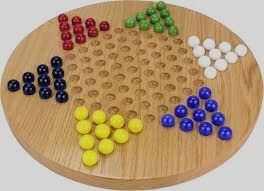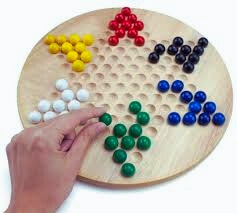
OBJECTIVE OF CHINESE CHECKERS: Be the first player to get all your pieces to “home.”
MATERIALS: Star-shaped Checker board, 60 pegs (6 different colored sets of 10)
NUMBER OF PLAYERS: 2, 3, 4, or 6 players
TYPE OF GAME: Board game
AUDIENCE: All ages
OVERVIEW OF CHINESE CHECKERS RULES
Chinese Checkers is a strategy board game, and despite the name, the game originated in Germany, where it was called Sternhalma! It is a simpler version of the game Halma, which is an American game.
The game aims to move all of one’s pieces across the hexagonal board to the “home,” a corner across the board from a player’s starting corner. Players use single-step moves and jumps to win. Play continues until all players place, i.e., a second, third, … place.
Below, we will explore the great Chinese Checker rules. We have also created a section discussing various strategies for the game.
SETUP FOR CHINESE CHECKERS

You can play Chinese Checkers with 2, 3, 4, or 6 players. You will setup the board differently depending on how many players there are.
Players each choose a color and its ten corresponding pegs. You will leave the unused pegs to the side.
WHAT’S IN THE BOX
In Chinese Checkers, you will need a 6-sided pointed starboard. Your game will also include six different sets of colored pegs or marbles. The only other material included is the rulebook.
TWO PLAYERS
In two-player games, the players can play with either 1, 2, or 3 sets of pegs each.
If the players choose to play with one set each, they will set up in opposite-facing starting areas.
When you play with two sets each, you can either set up in starting areas across from each other or all choose to line up in a row so that you have one set facing each other and one facing an empty section.
Finally, with three sets, each player will take a side of the board with three sections facing the other players’ sections.
THREE PLAYERS
For three-player games, there are two ways to play. Players can set up so that their section faces an empty section of the board. The other way to play is to get two sections next to each other on the board.
FOUR PLAYERS
There are two ways to play games with four players. Each player can get their section facing another player, or players can play as teams. If you play with teams, players will take a section across from their teammates.
SIX PLAYERS
Six-player games can also be played as individuals or in three teams. Each player picks a section on the board to play with in individual play. In team play, teammates will set up across from each other on the board.
HOW TO PLAY CHINESE CHECKERS

You will choose a random first player. On your turn, you will choose a single peg to move. Once the peg reaches the end of its movement, your turn will end, and the player to your left will start their turn. The goal is to move all your pegs into the opposing section(s), also known as “Home”.
MOVEMENT
There are two types of movement in Chinese Checkers. You will be able to move single spaces, or jump over pieces, sometimes even multiple times before ending your turn!
SINGLE MOVEMENT
The standard way to move is to move one space in any direction. This movement forward ends your turn.
JUMPING
When jumping, there must be a peg in the way of your movement. It does not matter who the peg belongs to. You will place your peg on the opposite side of the peg in the direction you wish to go. This does not end your turn though! If there is another peg next to your peg that just jumped, you may jump the peg if there is an open adjacent space near it. You may keep jumping over pegs until you can no longer jump. This ends your turn.
Once a player moves their peg into their Home section, it cannot move out; it can move only further into the section.
ANTI-SPOILING LAWS
Some rules claim blocking players with your pegs in their home triangle is legal. However, anti-spoiling rules claim these pegs do not stop a player from winning.
An anti-spoiling rules refers to home rules, or sometimes tournament rules, that improve the game flow. A common one in Chinese Checkers is you are not allowed to keep a player from winning by refusing to remove your peg from your starting area. Meaning the game will be won once a player has filled all their home spaces.
END OF GAME
A player or team wins the game once all their pegs have been moved into the opposing facing sections. The first team/player to do so will take first place!
If you enjoyed this game, try out checkers or chess for more fun strategy games, or our list of strategy games from history. If you want games with wild boards, try out Abalone.
CHINESE CHECKERS STRATEGIES
Chinese Checkers take time and practice to master, but some knowledge of common strategy can’t hurt. Here, we’ve compiled a list of a few moves and playstyles you can use to improve your game.
- Practice: We would be wrong, not to mention the best way to get better is practice. Practice with yourself, friends, online, anywhere you can!
- Direct Routes: Players often think of moving their pieces out from the center of the board. This is not very effective as speed is your main objective. You are trying to get from point A to point B as quickly as possible, so a direct route is the best even if your pieces get jumped over a time or two.
- On the Defense: Some players prefer to leave some of their pieces in their home section to block a win from their opponent. However, many players find this unsportsmanlike, so ask if this would be frowned upon before the game.
- Play your Opponent: Knowing what your opponent will likely do on their turn is a great advantage. Playing with the same players can help you spot their playstyles and predict where they will move before they do.
- Jumps: Set Yourself up for jumps. Moving your pieces out from the front can create some great opportunities for pieces in the back to jump forward across the board.
SUPER CHINESE CHECKERS RULES VARIATION
This variation of the standard Chinese Checkers rules allows for something called “long jumps”. A long jump is an extension of a standard jump. The peg you are jumping over will be your mid point of every jump. A standard jump has 0 spaces in between, but a long jump could have any number of empty space in between their piece and the mid point. To perform a long jump, all spaces between the starting space and end space must be empty, except for the peg at the mid point of the jump.
FAQ
Can You Jump Your Pieces in Chinese Checkers?
You can jump the pieces of any player, including yourself or teammates.
Can You Move Backwards in Chinese Checkers?
You can move your pieces in any direction in Chinese Checkers.
What Is the Best First Move In Chinese Checkers?
The most strategic move in Chinese Checkers is called the Sidewinder, when a player moves out their outwardmost corner pieces diagonally out from their section.
- 12 BEST HARRY POTTER BOARD GAMES - November 16, 2023
- 50 BEST HALLOWEEN GAMES - October 4, 2023
- 50 BEST CHRISTMAS GAMES - September 13, 2023